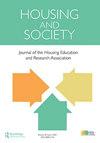Unsustainable inequalities: social justice and the environment
Q2 Social Sciences
引用次数: 0
Abstract
UK highlights the extent to which tenants can, in fact, exercise choice and agency within the rehousing process. As Watt concedes, this contests the unremittingly coercive regeneration portrayal embodied by the state-led gentrification discourse. Moreover, drawing on his own rich body of evidence, Watt substantially complements existing knowledge on this aspect of the estate regeneration debate, as embodied in the diverse perspectives of London estate residents recounted in Chapter 10. Beyond this, it is argued that a singular focus on forced displacement due to estate demolition foregrounds “what leaving estates means to residents” but in doing so “underplays the sociological, spatial and housing complexities of living at estates” (p. 8). This observation seems highly relevant in an era when large and complex estate renewal projects are often scheduled to extend over decades – a timescale necessitated under the mixed tenure renewal model, where the associated market drip-feeding logic of participating for-sale housing developers prioritizes resulting price (and profit) maximization. Contrasting with the official regeneration discourse of “creating better places and lives,” Chapter 9 presents graphic evidence suggesting that project implementation is generally experienced by residents as “physical, social, symbolic and psychosocial degeneration” (p. 263). It is left somewhat unclear whether such an outcome is inevitable, or whether it reflects deficient – and possibly improvable – project management practice. Specifically, this downbeat assessment seems to defy the claims of some regeneration practitioners that there is potential for long-running redevelopment of large estates to be implemented via a modularized approach that minimizes exposure to disruption at any one time. Justifiably, Watt stakes a claim for his book as the first to provide “a theoretically informed, empirically rich account of the development and consequences of estate regeneration in London” (p. 13). However, while many aspects of the story are admittedly specific to the urban history, politics and governance of the UK capital, the book’s appeal should far transcend a Londonor UK-focused readership. Many of its observations and findings will resonate for scholars of social housing in pressured urban property markets, the world over, making it a valuable resource for postgraduate students of social geography and urban planning across many countries.不可持续的不平等:社会正义与环境
英国强调,事实上,租户在安置过程中可以在多大程度上行使选择权和代理权。正如瓦特所承认的那样,这与国家主导的绅士化话语所体现的坚持不懈的强制性再生形象相矛盾。此外,根据他自己丰富的证据,瓦特在很大程度上补充了关于遗产再生辩论这一方面的现有知识,这体现在第10章中讲述的伦敦遗产居民的不同观点中。除此之外,有人认为,对因房地产拆迁而被迫流离失所的单一关注“离开房地产对居民意味着什么”,但这样做“低估了居住在房地产的社会学、空间和住房复杂性”(第8页)。在一个大型和复杂的房地产更新项目通常计划延长数十年的时代,这一观察结果似乎非常重要——在混合保有权更新模式下,这是一个必要的时间尺度,在混合保有期更新模式中,参与待售房地产开发商的相关市场滴流逻辑优先考虑由此产生的价格(和利润)最大化。与“创造更好的地方和生活”的官方再生话语相比,第9章提供了图形证据,表明项目实施通常被居民视为“身体、社会、象征和心理退化”(第263页)。目前还不清楚这样的结果是不可避免的,还是反映了项目管理实践的不足——甚至可能是可以改进的。具体而言,这一悲观的评估似乎违背了一些再生从业者的说法,即大型房地产的长期重建有可能通过模块化的方法来实施,从而最大限度地减少任何时候的干扰。有理由的是,瓦特声称他的书是第一本提供“关于伦敦房地产再生的发展和后果的理论依据和经验丰富的描述”的书(第13页)。然而,尽管故事的许多方面都是公认的英国首都的城市历史、政治和治理所特有的,但这本书的吸引力应该远远超过以伦敦为中心的英国读者群。它的许多观察和发现将引起世界各地压力重重的城市房地产市场中社会住房学者的共鸣,使其成为许多国家社会地理和城市规划研究生的宝贵资源。
本文章由计算机程序翻译,如有差异,请以英文原文为准。
求助全文
约1分钟内获得全文
求助全文
来源期刊

Housing and Society
Social Sciences-Urban Studies
CiteScore
2.30
自引率
0.00%
发文量
10
期刊介绍:
Housing and Society is the journal of the Housing Education and Research Association (HERA). The journal supports the mission of HERA by providing for the dissemination of research and other scholarly work. Submissions from a broad range of perspectives are encouraged. Topics in housing include: policy, design, social aspects, gerontology, behavioral aspects, energy/environment, equipment, interiors, economics, theory/model development, education, and program development or evaluation. The journal welcomes the submission of original research articles, notes and commentaries. Notes are shorter manuscripts presenting succinct information on housing related to one of the following categories: - Research: exploratory or not heavily theory-based or statistically analyzed - Academic: innovative teaching ideas - Program: development, implementation, and/or evaluation of Cooperative Extension or other housing programming efforts - Policy: examination of policy impact, comparative analysis, and/or need to achieve housing goals - Reviews: books, documentaries, etc.
 求助内容:
求助内容: 应助结果提醒方式:
应助结果提醒方式:


